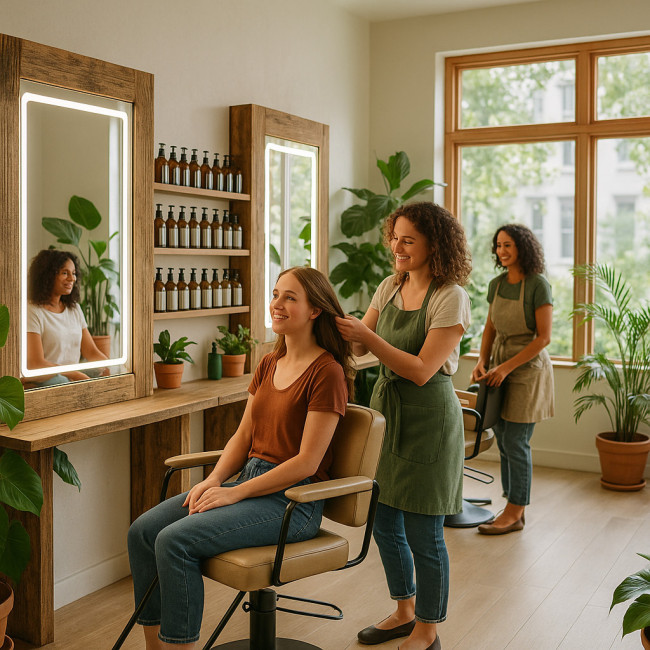Green salon moves: how a coiffeur can switch to eco-friendly products
Ready to reduce chemical waste, cut energy bills and attract eco-conscious clients? This guide shows you, step by step, how to transform a traditional hair salon into a low-impact, planet-friendly space without sacrificing style or profit.
Why going green pays off for coiffeurs

Eco-friendly salons are no longer niche. A 2024 consumer survey from Statista reports that 62 % of beauty customers now “actively seek sustainable options”. Green upgrades lower water and power consumption, reduce staff exposure to harsh ingredients and open the door to premium, values-driven pricing. Beyond financial metrics, stylists repeatedly report a morale boost when they realise their day-to-day craft can actively protect the planet. Local authorities, trade associations and lifestyle magazines frequently spotlight pioneering salons, providing free publicity that accelerates word-of-mouth growth and cements brand authority among conscious consumers.
- Client loyalty: Eco credentials raise trust and word-of-mouth referrals.
- Cost savings: Low-energy dryers and refillable bottles slash overheads within months.
- Differentiation: On directories such as Artfolio's hair stylist listing, “sustainable” tags boost ranking and click-through rates.
Step-by-step roadmap to a green product lineup
1. Audit your current backbar
Print last month's stock list and highlight items that contain:
- Sulfates (SLS or SLES)
- Parabens
- Petrolatum or mineral oil
- Non-recyclable single-use plastics
These ingredients are red flags for both health and environment. Mark them for phase-out.
2. Research certified alternatives
Look for third-party eco labels: COSMOS Organic, Ecocert, B-Corp or Vegan Society. Cross-reference ingredients on the European Chemicals Agency database to confirm biodegradability. Inspiration often comes from outside the beauty world; for example, jewellery studios switching to eco-certified metals face similar traceability challenges.
3. Run small-scale trials
Swap one shampoo and one styling product first. Track:
- Client feedback (scent, texture, results)
- Cost per application
- Rinse time (water use)
4. Train the team
Host a 30-minute briefing on new ingredients and application techniques. Stylists who can speak confidently about carbon impact instantly become micro-influencers for your brand.
5. Promote the switch
Update window decals, service menus and your online profile. A strong sustainability story, just like those in eco-minded design portfolios, attracts higher-value jobs.
Core product categories to greenify
| Category | Traditional Issue | Eco Swap | Quick Win Metric |
|---|---|---|---|
| Shampoo & Conditioner | Sulfates, silicone buildup | Solid bars or concentrates | Up to 80 % water saved |
| Hair Color | Ammonia, PPD | Low-MEA or plant-based dyes | 50 % less chemical fumes |
| Styling Sprays | Aerosol propellants | Non-aerosol pump mists | Zero VOC release |
| Disposable Towels | Single-use paper waste | Bamboo fibre towels | Compost in 12 weeks |
| Retail Packaging | Virgin PET bottles | Refill stations & glass jars | Plastic use cut by 70 % |
Cost vs. ROI: crunching the numbers
A common fear is rising product cost. In reality, savings appear quickly:
- Concentrated shampoos last 2–3 × longer per litre.
- Energy-efficient LED mirrors reduce lighting bills by roughly €400 per year.
- Water-saving shower heads pay for themselves within six months.
Factor in an average 15 % service price uplift for “green menu” treatments and the payback period often drops below one year.
Marketing your eco transformation
Storytelling converts upgrades into bookings. Borrow tactics from eco-smart retail displays:
- Show before/after photos of plastic use.
- Publish monthly impact stats (litres of water saved).
- Host a “bring-your-own-bottle” refill event.
Collaborate with sustainable fashion stylists or green-focused models (eco-friendly model bookings) for cross-promotions.
Case study: 30-day partial switch
Emma, a freelance coiffeur in Lyon, replaced 40 % of her backbar with certified organic products and installed a water-efficient rinse head.
- Product expenditure: +€110
- Utility savings: –€65
- Service revenue uplift: +€240
Net win after 30 days: €195. Client re-booking rate climbed from 71 % to 83 %.
Quick quiz: test your green salon savvy
FAQ
- Do eco-friendly hair colours cover greys as effectively?
- Yes. Modern low-MEA and plant-based dyes achieve up to 100 % grey coverage; processing time may be five minutes longer.
- Will my insurance change if I store fewer chemicals?
- Some insurers offer minor premium reductions because fire risk decreases; always notify your broker before switching.
- How do I dispose of leftover non-green stock?
- Partner with a cosmetics recycling program or donate sealed items to vocational schools instead of sending them to landfill.
- Can I charge more for sustainable services?
- Market data shows clients accept a 10–20 % premium when benefits are clearly communicated.
Take action today
Start with one category—shampoo bars or refillable colour tubes—and measure the impact. As your numbers improve, expand the switch. Your clients, team and the planet will thank you.
Next step: build your updated “green salon” profile and watch eco-minded clients book faster than ever.











